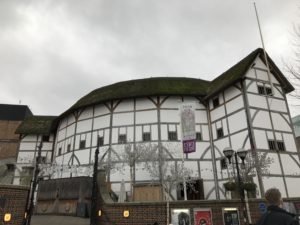Hi from rainy, chilly London. We started the day by journeying to English major Mecca: Shakespeare’s Globe Theater. The current theater is technically the 3rd Globe theater: the first one burned down due to a misfortune in a performance of Henry VIII in 1613. The play called for cannon fire: however, the Globe had a thatched roof….there was a stray spark….it burned in 2 hours. The theater was rebuilt in 1614, but Shakespeare died in 1616 and had little to do with the 2nd iteration. Then came killjoy Oliver Cromwell: the Puritan leader cancelled Christmas, banned plays and pretty much anything else that was remotely fun or entertaining. The Globe was pulled down in 1642. The current reconstruction rests a couple of hundred feet away from the original site, which is now a car park area. Amazingly, the reconstruction was all done with traditional methods and materials, meaning no nails, etc. Goat’s hair plaster, English green oak, Elizabethan era paint recipes and colors, and gold leaf on the stage details. Since it is an open air theater, there are no performances this time of year, sadly. Next time!



The Globe is on the south bank of the Thames directly opposite St. Paul’s Cathedral and by the Millennium Bridge, the only solely pedestrian bridge across the Thames in London. After tea and cake at The Swan Tavern (adjacent to the theater), we traveled the foot of the bridge and happened upon another Christmas market, with chalet style stalls, food vendors, beer and a carousel. We explored the market for last minute gifts, then crossed the bridge and walked to the foot of Christopher Wren’s masterpiece. Wren is responsible for the design of more than 50 churches in London due to the massive scale of the great fire, but none are like St. Paul’s. Consecrated in 1697, St. Paul’s was the 4th cathedral on this site and took more than 32 years to complete. The dome is 365 feet high and dominated the London skyline for centuries. The cathedral survived the Blitz, but was hit by three bombs at various times. One destroyed the high alter; another struck the north transept and detonated with such force that the dome was shifted slightly. The third bomb was on a time delay and was diffused before detonation. When it was removed and remotely detonated, it left a 100 foot wide crater: it would have destroyed the entire cathedral. Thankfully, that did not happen, and we are able to appreciate the dome, cupolas, clock tower and beautiful details of this landmark. I know it looks like night time in these photos, but it’s 4 pm!


One of the joys of most European cities, and London especially, is the juxtaposition of old and new, and “old” is a wide range of architecture styles. We found this church, St.-Martin-Within-Ludgate, wedged in between more “modern” construction (i.e. Georgian? Victorian?).

We also were exploring the eastern end of Fleet Street and stumbled on another of Christopher Wren’s gems just off in a nook: St. Bride’s Church. First of all, I had no idea there was a saint named bride, and secondly, is this church’s steeple why our wedding cakes typically look like they do? I have no idea, but it is beautiful.


We kept this day short – our feet are aching from all the walking, and we decided to give them a bit of break. Back to it tomorrow on Christmas Eve. Thanks for checking in!